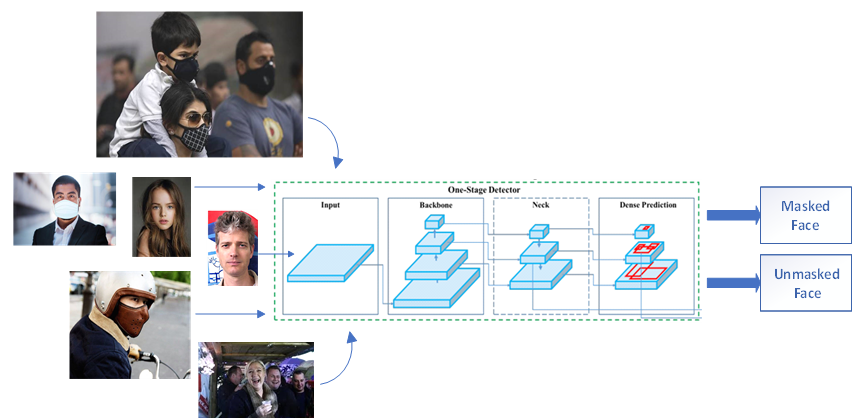YOLO-V4 Based Real-Time Face Mask Detection via Unmanned Aerial Vehicle
DOI:
https://doi.org/10.58190/ijamec.2024.106Keywords:
YOLO-v4, object detection, mask detection, unmanned aerial vehicle, COVID-19Abstract
COVID-19, which started in Wuhan city of China's Hubei province and then affected the whole world, continues to spread despite the measures taken. One of the most important of these measures is to use a mask. In some countries, while wearing a mask is mandatory in crowded environments, it is just as difficult to control it. Failure to detect individuals violating the mask
causes the virus to spread, resulting in an increase in the number of cases and an increase in the number of deaths. Therefore, detecting the mask and taking action against it is an extremely important issue. In this study, in addition to making mask detection easily and quickly, mask detection is made by using unmanned aerial vehicles (UAVs) using images taken from different
angles and different heights. For mask detection from UAV images, training and validation processes were applied using the YOLO-v4 algorithm on a public dataset containing 1510 masked and unmasked human face images. As a result of the training on this dataset, mean-average precision (mAP) was achieved with a success rate of 92.06%. Then, real-time mask detection was
performed on the images taken with the DJI Ryze Tello quadcopter using the trained network. The results showed that the UAV is applicable in crowded environments required for autonomous mask detection and gives successful results.
Downloads
References
[1] D. P. Scheel., “Since January 2020 Elsevier has created a COVID-19 resource centre with free information in English and Mandarin on the novel coronavirus COVID-,” Ann Oncol, no. January, pp. 19–20, 2020.
[2] WHO Coronavirus(COVID-19) Dashboard, [Online]. Available: https://covid19.who.int
[3] W. J. Wiersinga, A. Rhodes, A. C. Cheng, S. J. Peacock, and H. C. Prescott, “Pathophysiology, Transmission, Diagnosis, and Treatment of Coronavirus Disease 2019 (COVID-19): A Review,” JAMA - J. Am. Med. Assoc., vol. 324, no. 8, pp. 782–793, 2020, doi: 10.1001/jama.2020.12839.
[4] Coronavirus disease (COVID-19) advice for the public: When and how to use masks, [Online]. Available: https://www.who.int/emergencies/diseases/novel-coronavirus-2019/advice-for-public/when-and-how-to-use-masks
[5] V. C. C. Cheng et al., “The role of community-wide wearing of face mask for control of coronavirus disease 2019 (COVID-19) epidemic due to SARS-CoV-2,” J. Infect., vol. 81, no. 1, pp. 107–114, 2020, doi: 10.1016/j.jinf.2020.04.024.
[6] N. H. L. Leung et al., “Respiratory virus shedding in exhaled breath and efficacy of face masks,” Nat. Med., vol. 26, no. 5, pp. 676–680, 2020, doi: 10.1038/s41591-020-0843-2.
[7] M. Loey, G. Manogaran, M. H. N. Taha, and N. E. M. Khalifa, “A hybrid deep transfer learning model with machine learning methods for face mask detection in the era of the COVID-19 pandemic,” Meas. J. Int. Meas. Confed., vol. 167, no. May 2020, p. 108288, 2021, doi: 10.1016/j.measurement.2020.108288.
[8] M. Loey, G. Manogaran, M. H. N. Taha, and N. E. M. Khalifa, “Fighting against COVID-19: A novel deep learning model based on YOLO-v2 with ResNet-50 for medical face mask detection,” Sustain. Cities Soc., vol. 65, no. June 2020, p. 102600, 2021, doi: 10.1016/j.scs.2020.102600.
[9] G. Jignesh Chowdary, N. S. Punn, S. K. Sonbhadra, and S. Agarwal, “Face Mask Detection Using Transfer Learning of InceptionV3,” Lect. Notes Comput. Sci. (including Subser. Lect. Notes Artif. Intell. Lect. Notes Bioinformatics), vol. 12581 LNCS, pp. 81–90, 2020, doi: 10.1007/978-3-030-66665-1_6.
[10] S. A. Sanjaya and S. A. Rakhmawan, “Face Mask Detection Using MobileNetV2 in the Era of COVID-19 Pandemic,” 2020 Int. Conf. Data Anal. Bus. Ind. W. Towar. a Sustain. Econ. ICDABI 2020, 2020, doi: 10.1109/ICDABI51230.2020.9325631.
[11] M. Jiang, X. Fan, and H. Yan, “RetinaMask: A Face Mask detector,” 2020, [Online]. Available: http://arxiv.org/abs/2005.03950.
[12] X. Wang, Z. Chen, B. Wei, and M. Ling, “Application of Pruning Yolo-V4 with Center Loss in Mask Wearing Recognition for Gymnasiums and Sports Grounds of Colleges and Universities,” 2020 IEEE 6th Int. Conf. Comput. Commun. ICCC 2020, pp. 1373–1377, 2020, doi: 10.1109/ICCC51575.2020.9345257.
[13] J. Yu and W. Zhang, “Face mask wearing detection algorithm based on improved yolo-v4,” Sensors, vol. 21, no. 9, 2021, doi: 10.3390/s21093263.
[14] Anadolu Ajansı."Aydın'da maske takmayanlar drone ile tespit edilip uyarıldı"(22.05.2020), 1. Available: https://www.aa.com.tr/tr/turkiye/aydinda-maske-takmayanlar-drone-ile-tespit-edilip-uyarildi/1850647
[15] Labeled Mask Dataset, [Online]. Available: https://www.kaggle.com/techzizou/labeled-mask-dataset-yolo-darknet
[16] Z. Wang et al., “Masked Face Recognition Dataset and Application,” no. March, 2020, [Online]. Available: http://arxiv.org/abs/2003.09093.
[17] Mask Wearing Dataset, [Online]. Available: https://public.roboflow.com/object-detection/mask-wearing
[18] Simulated Face Masked Dataset (SFMD), [Online]. Available: https://github.com/prajnasb/observations
[19] A. Bochkovskiy, C.-Y. Wang, and H.-Y. M. Liao, “YOLOv4: Optimal Speed and Accuracy of Object Detection,” 2020, [Online]. Available: http://arxiv.org/abs/2004.10934.
[20] J. Redmon and A. Farhadi, “YOLOv3: An Incremental Improvement,” 2018, [Online]. Available: http://arxiv.org/abs/1804.02767.

Downloads
Published
Issue
Section
License
Copyright (c) 2024 International Journal of Applied Methods in Electronics and Computers

This work is licensed under a Creative Commons Attribution-ShareAlike 4.0 International License.




